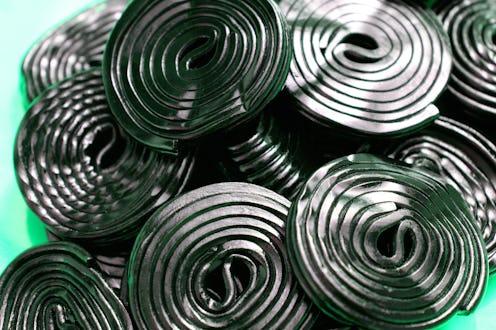So, here is a fun Halloween warning from the Food and Drug Administration (FDA): Eating too much black licorice can apparently cause some unpleasant health problems. Somewhat hilariously, the FDA has chosen to give us this warning in the form of a spooky video — and while it may not be the scariest thing you watch this Halloween (here are some better suggestions), it’s still a little distressing. The good news, though, is that we don’t need to freak out about it quite yet — because it turns out that the video doesn’t include a key piece of relevant info: Exactly how much black licorice you have to eat before your health starts to suffer from it. And the answer to that question is... probably a lot more than you think.
First things first, though: What’s the issue, exactly? Well, black licorice’s main source of sweetness is a compound called glycyrrhizin — and when glycyrrhizin is consumed in large quantities, it can cause hypokalemia, or very low levels of potassium, as well as things like tachycardia (a condition where the heart beats faster than normal while atrest), muscle weakness, and cardiac arrest. As such, if your body gets overloaded with the stuff, you might experience — as the FDA’s bizarrely spooky video reminds us — “high blood pressure, swelling, lethargy, [and/or] congestive heart failure.”
Uh… yikes.
Naturally, upon hearing this somewhat alarming news, the first question that came to mind for me was, “…But how much licorice do you really need to eat in order for it to become a problem?” If I’ve learned nothing else from the various other investigations along similar lines that I’ve conducted over the years, it’s that “DON’T EAT TOO MUCH OF THIS ONE THING OR YOU WILL DIE!!!!!!” warnings usually mean, in reality, “Don’t eat this ABSURD AMOUNT of this one thing or you will die” — wherein that ABSURD AMOUNT is an amount that most humans don’t typically consume in one sitting. This, in turn, means that the “DANGEROUS FOODSTUFF” in question usually isn’t actually a threat in our day-to-day existence.
And hey, guess what? That’s the case here, too — and, somewhat ironically, we’ve got the same organization to thank for the additional information as we do for the scary warning in the first place: According to a consumer update on the FDA’s website dated Oct. 30, 2017, “If you’re 40 or older, eating 2 ounces of black licorice a day for at least two weeks could land you in the hospital with an irregular heart rhythm or arrhythmia.”
Not sure what two ounces of licorice looks like? Let me show you. This is what 2.5 ounces of Twizzlers looks like (and yes, I realize that these are Strawberry Twizzlers, but let’s not forget that Twizzlers also comes in a black licorice flavor that is surprisingly difficult to find online):
Also, this is what 1.8 ounces of Good & Plenty looks like:
So basically, in order to consume enough black licorice for it to become an actual health issue, you need to eat just under one standard package of Twizzlers or just over one standard package of Good & Plenty every single day for at least 14 days. Also, you have to doso under the condition of being at least 40 years old.
That is… A Lot. And I say that as someone who actually quite likes black licorice.
That said, though, apparently there have been recent cases of people starting to feel a little off after eating too much black licorice. According to Linda Katz, M.D., the FDA did receive a report of someone having this exact problem last year; additionally, cases pop up periodically in the literature highlighting the effects of consuming too much licorice.
A study from 2012, for example, detailed a case in which a 35-year-old Egyptian man with no history of fever, chills, upper respiratory tract infection, back pain, or trauma arrived at the emergency room “with progressive weakness that started in his lower extremities and quickly progressed to involve the upper limbs.” It was determined that his potassium levels were low — and it later came out that during the month of Ramadan, he had drunk a liter of the licorice root-based drink erk soos every day.
Additionally, a 2017 study featured the case of a 51-year-old man who arrived at the emergency room complaining of having had abdominal pain for three days and suffering from a whole bunch of digestive issues. He, too, was found to have hypokalemia — and later told doctors that he had recently been eating around 50 black licorice jelly beans a day.
The good news is that treatment for low potassium levels caused by eating too much black licorice is easy: Just stop eating the stuff. According to Linda Katz, your potassium levels should return to normal shortly thereafter. So, y’know, at least there’s that.
The FDA seems to put out this warning every year — here’s an example dating back to 2011 — which is kind of interesting to me; honestly I didn’t think enough people even liked black licorice for it to be a real problem, on Halloween or at any other time of year. But hey, better safe than sorry, I guess. And, I mean, what are the chances that your trick-or-treat haul will even include that much licorice, anyway?
(If it does, I’ll totally trade you for it if you don’t want it.)
Happy Halloween!
